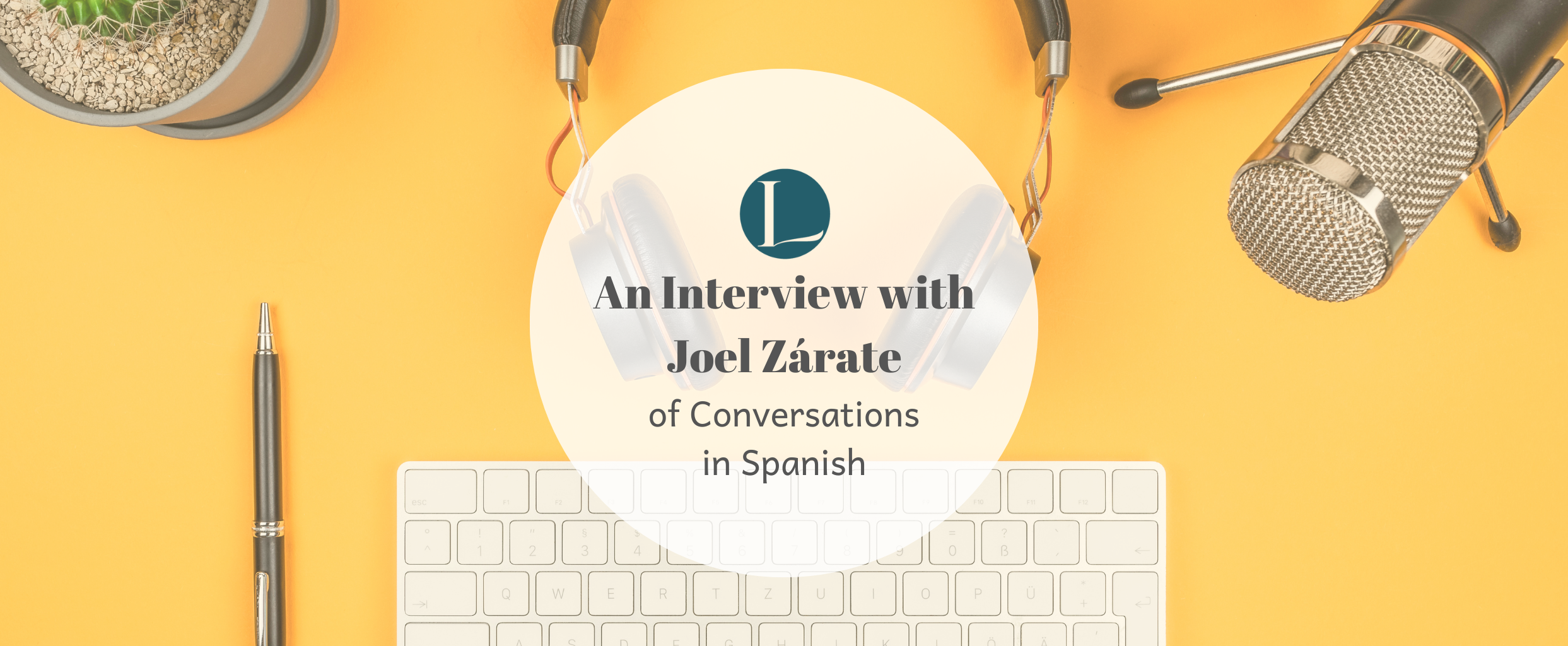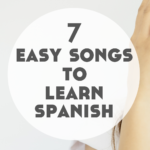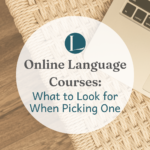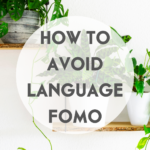February 10th, 2023
Conversations In Spanish – Joel Zárate: “Each Language has Something Unique”
We have our first guest on the How to Learn a Language podcast! Yay! Let’s meet Joel Zárate, host of the Conversations in Spanish Podcast and learn how he learns languages.
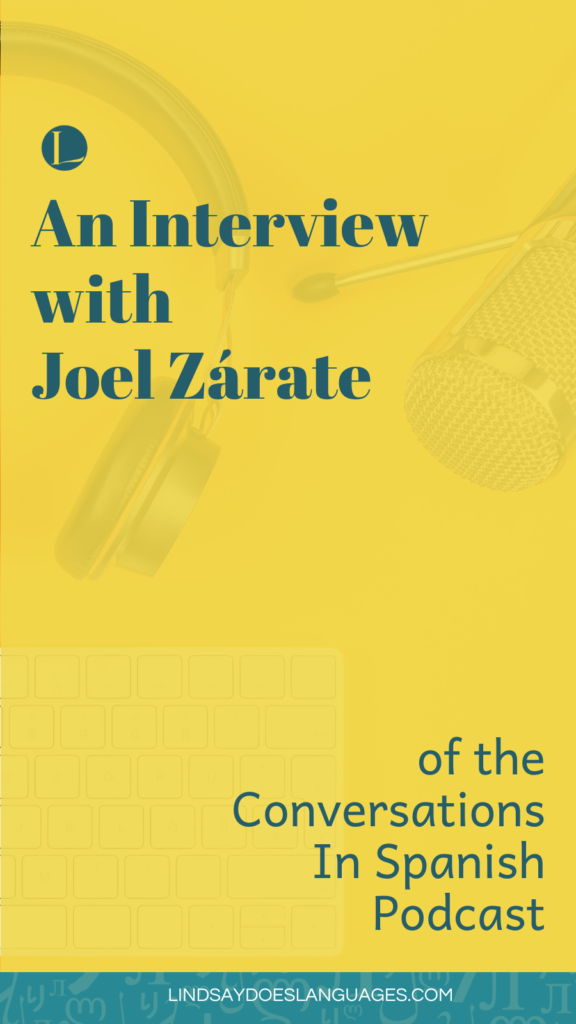
Joel’s Podcast Links (More than Conversations In Spanish!)
Ok, so the title is a lie. Joel isn’t just the host of Conversations In Spanish. He’s the host of so many great podcasts – both for Spanish learners and language teachers! Here’s the full list so you can find and subscribe to the ones most relevant to you:
And, I actually recorded a couple of episodes with Joel! Here’s the links to those specific episodes:
Yo Hablo Español/Conversations in Spanish – Lindsay Comparte su Historia
How to Teach a Language – An Interview with Lindsay from Lindsay Does Languages
You can enjoy How to Learn a Language in the way that suits you best – video on YouTube, podcast, or read the full transcript here on the blog.
The Video
The Podcast
Or you can read our interview below. Please note, the transcript is created by a computer. Although it’s checked as much as time allows, there may be minor errors!
The Transcript
Episode Introduction
Lindsay:
Hello!
Hola!
I’m going to say hola this week because I have a guest joining me on this episode of How to Learn a Language.
And just such a wonderful, wonderful human.
This is Joel Zárate, Joel Zárate in Spanish and so many podcasts.
I’ve got the list.
I’m looking at the list as I’m recording this.
If you’re listening on the podcast feed, I’m recording a video intro for this for YouTube.
And so I’m looking now to the left to the list because there’s so many good podcasts that Hoyle makes.
Conversations in Spanish, help me learn Spanish, mini stories to learn Spanish, Spanish for beginners, vocabulary in Spanish, how to teach a language, and a brand new podcast Yo Hablo Español.
We had a great chat.
That one is in Spanish, me talking about my experience learning not just languages, but Spanish in particular, motivation, what Shakira has to do with it all.
And yeah, definitely worth a listen.
But do have a look.
I’ll pop links in the show notes in description so that you can catch up with everything.
Just the wonderful, wonderful amount of podcasts and yeah, enjoy the interview and I’ll be back at the end of check in.
Hello, Hola, Joel or in Spanish, Joel.
Joel:
That’s right.
Lindsay:
We’ll stick to Joel as we’re going to be talking in English today, but I am delighted to have you join me and it’s just really looking forward to learning more about you and your story and your own language learning and what you do for language learners as well because, wow, there’s so much good stuff.
First of all, can you share a little bit about your story yourself?
Where would you like to begin?
Introduce yourself?
Joel’s Introduction
Joel:
Well, thank you so much, Lindsay.
It’s a pleasure to be here to share this space, this time and thank you so much for inviting me to your YouTube channel and I’ll talk a little bit about myself and hopefully I won’t take 20 minutes because I will say something else.
I will say so many things, but my name is Hoyle Sarate and I live in California and I’m also used to Joel and I was born in Mexico, the state where I was born is actually called El estado de Mexico, the state of Mexico and it’s funny because people usually hear the state of Mexico, but what state is that?
The state is actually El estado de Mexico and so I was born in El estado de Mexico and then I moved to the states after finishing high school.
My father emigrated to the states when I was six years old maybe and so for a while we were a little distance, this distance actually, we were a little distant and so when I finished high school, he said, you know, why don’t you come to the states and study?
You can go to the community college and pursue a career here and so I ended up doing that.
I moved to the states and went to the local community college in Northern California, which is called the Santa Rosa Junior College and I didn’t speak a word of English when I moved to the states, I was 19, I was 19 or 20, I don’t remember.
Joel’s Language History
And I started learning English as a second language, so I learned English at the community college and then eventually I was able to move into the academic English and regular classes like anthropology, communication studies and all of that.
But later on I decided to study languages, I studied French at the community college and I studied some Italian and it was interesting because when I was an ESL student, one of the things that I really loved to do was to help my classmates.
For some reason, it was not difficult to me to understand the language and I enjoyed just listening and speaking and I noticed that many of my classmates were struggling and so I would help them and that gave me personal pride, personal satisfaction and I was able to help my classmates and so I
ended up working at the tutorial center at the Santa Rosa Junior College, tutoring English and tutoring Spanish.
So that’s how I started to grow this love for languages, that I was helping ESL students and I was helping Spanish students and I truly enjoyed that.
And then I went on to study French and Italian and I took a little bit of German and I had a very good French instructor and I learned several strategies, several strategies to practice the language and that also gave me strategies that I was just seeing when I was helping ESL students and Spanish
students.
So, sure story long, that’s how I ended up with languages and how I love learning and teaching languages.
Joel’s Academic Studies
Like I said, that’s what I was doing at the community college and I went to study at the University, at the California State University Sonoma campus, which we know here at Sonoma State University.
I studied a bachelor’s degree in Spanish and a bachelor’s, no bachelor’s degree in Spanish and then a master’s degree in Spanish and a master’s degree in TISO and I directed my studies to second language acquisition and Spanish second language acquisition, which has to do with everything that we
know from the research studies and the literature that informs how it is that we develop the ability to speak languages.
So, I studied that and as of now I speak five languages fluently, I speak Spanish, of course my native language, then English, French, Italian and Portuguese.
And I love learning how to say something in other languages, so I have learned, yeah, how to say many things in other languages but we’ll get into that a little bit more later.
But that’s kind of like my story and so now I am creating content to help my audience to learn Spanish.
I love that what started out as necessity with learning English, having moved to America, then you found this love from that.
Finding Language Love from Necessity
Lindsay:
That’s so cool because you so often hear of people needing to learn a language out of necessity and then it becomes a frustration and it becomes something that is kind of resented like, oh, I have to learn English, I have to learn Spanish, you know.
And so to hear how you found your way to actually loving languages do that is really cool.
Joel:
Thank you.
Yeah, yeah, I think that first I truly enjoyed helping my classmates and students who were learning Spanish and then I realized actually I also enjoyed learning languages and I am actually understanding how to help them.
So that’s how I came up.
But I remember when I came to the States, I didn’t speak a word of English.
And in Mexico and also in other countries, when you’re studying high school, it’s mostly just a few words and grammatical rules and you don’t have native speakers.
So I would say, La Tableau or Estudí.
And people would be looking at me and I thought, wow, I have no idea how to say anything in English.
But yeah, that’s how sometimes necessity leads you to find something that you later realized, actually I can do this.
We just get this incorrect notion that maybe something is too difficult, too hard because we see it from outside.
And when you actually engage in it, you realize, actually I can do this.
And that’s almost like for every job, right?
When you get a job, you feel like, I don’t know how I’m going to do it.
I don’t know how I’m going to do it.
And then once you start getting into it and doing it every day in your life, you realize, actually, I can do this and I can do it well.
Joel’s Language Motivations
Lindsay:
Yeah.
Why do you think it is?
What do you think it is that you like about learning languages?
Joel:
I have two reasons.
The main reason is that I just love to hear how other languages sound.
I get perspective also on how to appreciate the way that something is communicated in other languages without verbs, without objects, for example.
And each language has something unique.
And I particularly love sounds also.
Like, for example, I love the way that Filipino sound.
I’ll just say something Filipino just for the fun of hearing how it sounds like [speaks Filipino].
I just find it awesome.
What I said was, this is a podcast where you can learn about languages.
That’s what I said in Filipino.
But just the sounds and also Finnish, for example, [speaks Finnish].
I just enjoy learning and hearing the languages.
But the main reason why I decided to or why I also enjoy learning how to say things in other languages is because when I was in graduate school, and I actually on my podcast, excuse me, on my podcast, how to teach a language, I explain on episode two, the reason why I talk more fully about what I’m
just kind of what I’m about to mention.
Why Language Teachers Should Always Learn Something New
But when I was in graduate school, I had a very good professor who was originally from Korea, professor, He Won Gang who may rest in peace.
She was great.
She was very loving.
And in one of the graduate courses that I took with her, she was telling me, you know, one of the things that I recommend language teachers to do is to always learn something new in another language.
And the reason why is because when you’re teaching a language, even if it’s a second language, eventually you become comfortable with the language.
And then you begin to lose perspective on what it means to be the beginner who is perhaps having a harder time or or there are certain parts that are more difficult.
And if you are always learning something in another language and always position yourself as a beginner in another language, that will always give you perspective and you won’t lose sight on what it’s like to be a beginner or what it’s like to be a learner.
So for that reason, ever since I’ve been learning just how to say something in other languages.
And I have learned particularly phrases that I can use to welcome people to my podcast.
And on the podcast, how to teach a language, I give them an exercise.
So what I say is that I’m going to say a few things in this language in Chinese or Greek or Filipino or German.
And then at the end, I’m going to share the audio from the native speaker who told me how to say these phrases.
And you give them a try.
Now you have something that you can use to, that you can use to practice and always just have this fresh perspective.
And so that’s something that I do.
On Loving Language Sounds
But that’s also the reason why I love learning languages.
And it always reminds me of, okay, you know, how to pace myself, how to be a better Spanish instructor.
So, so that’s why I just, I just love learning.
I wish I could learn other languages.
I love the way Japanese sounds.
I know, I know it’s just, I just, every language is just, I love the way I saw someone who speaks Spanish.
For example, Japanese, I wish enjoy how it sounds.
I wish I could learn Japanese, German, Russian, Finnish, and I just, you can understand.
Lindsay:
Yeah, when I start thinking, I wish I spoke this, this, this, and I, and I aim to have a really short list if I start that sentence, but it just never is.
Oh, and that, oh, and I can’t learn that without that.
It’s just…!
So I can very much relate to what you’re saying.
And there is something so powerful about, especially when you’re teaching others language or teaching others how to learn a language about being in that position of a beginner, because it’s very easy to forget how different it is, the experience of being at each stage, you know, and what you do and
how you learn is so different along that whole journey of experience and ability in a language.
So I can very much relate to what you’re saying there.
Learning Through Audio
And you mentioned the podcast a few times and I wonder if you started that because it sounds like you’re quite a sort of audio, like, it sounds like you’re quite good at learning through audio.
I’m getting that impression.
Is that, is that a good assumption?
Is that linked to maybe where you started the podcast, you think?
Joel:
Part of it.
Yeah, part of it.
I, like I said, in graduate school, I studied second language acquisition, and there are different perspectives on how to, how to be a more effective language instructor, but one, one concept that is kind of like a consensus among the experts among the scholars in second language acquisition is that we need to learn a language in a communicative context where we can create what is called form meaning connections and I hope I hope I’m not getting too much slang, but it just basically means that the consensus is that context provides the opportunity to develop the subconscious command of a
language.
The more we isolate language from its context, then the more difficult, the longer it takes to be able to accomplish that.
So, the podcast allows me to create content that people can listen to while they are driving while they are doing something else.
Joel’s Podcasts (inc Conversations In Spanish)
Conversations In Spanish Podcast
So I have, I have a podcast, conversations in Spanish and other languages, podcasts that has episodes that go from 40 minutes to an hour and 30 minutes.
And all of that podcast is for people to be able to just listen while they are driving, they are doing something, and they get to hear two native speakers have a conversation that that provides that heavily provides everyday language.
And for example, I have a conversation with someone from Argentina or Mexico or my friend who also hosts the podcast, Alva, she also may have a conversation about.
So let’s talk about what you like to do in your life.
Do you play the guitar?
Do you do that?
So that provides just the everyday language to speak.
Or, for example, we have episodes about education in Mexico.
So what are the different levels of elementary school, secondary school.
And so you hear teacher school, all these vocabulary in context through a conversation between native speakers.
So that provides context.
So I am doing my part with my podcast to do that.
So with video, I would also love to do content in video, but as you know, video requires a lot more work.
So to produce one episode for YouTube requires more preparation and editing.
And so it’s a lot more, you have to spend a lot more time.
And that requires less time, although there is a lot of preparation that goes on for my podcast.
But if I may, I’ll just mention the podcast that I have.
I have one that is conversations in Spanish and other languages.
That’s for intermediate and advanced learners who can listen to native speakers have conversations and learn Spanish in context.
Help Me Learn Spanish Podcast
And I have another podcast called Help Me Learn Spanish Joel.
And that podcast is short conversations with about 15, 10, 20 minutes.
And this podcast is for beginners and intermediate.
And the goal of this podcast is to prepare them so that when they go to the conversations, they can learn with much, much more ease.
And so this podcast, the pace is lower and I put a lot of emphasis on vocabulary, grammar and everyday language.
So instead of just talking about how to use the present tense, I’m showing them how we’re using it in a conversation.
And they get the transcripts also on my website.
By the way, the transcripts are free if they want to get the transcripts.
They don’t have to subscribe to a newsletter or anything.
If they just go to my website, they’ll see that I have those transcripts.
Mini Stories Podcast
And I have a podcast with mini stories.
I write this mini stories that I like writing uplifting and also nice stories to also provide a different way to listen, to learning context.
And I put a lot of emphasis in vocabulary and style that will be useful when they actually want to speak.
Because I remember when I was learning English and instructors will give us, okay, so let’s read this novel.
And so when you’re learning a language, you cannot distinguish what word is the word that you use in everyday language.
Because let’s say you find, I remember, swiftly, the word swiftly.
And I remember looking in the dictionary and it defined it as rapido.
Rapido in Spanish is a common word that you use to have a conversation.
But swiftly in English, it’s not a word that you use.
We’ll just say, come on, swiftly, we have to go.
So there are materials for native speakers.
I can give you these words that where if you look at the dictionary, you may get the wrong idea.
And so I try to create content that provides language.
And hopefully in the future, I’m planning to launch new podcasts.
And among those podcasts, I am hoping that I launch a podcast for complete beginners.
And I’m excited about that because I just haven’t had enough time to do that.
But I want to have a podcast where the episodes help each other like units.
And it will be a great thing.
So hopefully by the time your audience is this video, I might have that podcast.
Yeah, so that’s why I got more for producing podcasts than I love it.
Finding a Love for Audio & Podcasting
Something that I didn’t mention about my story is that when I moved to the States, I was a radio host in a bilingual radio station.
And my show was in Spanish.
I was speaking English.
So that’s why also being in a podcast, I feel more comfortable in that environment.
Lindsay:
That makes sense.
That’s so cool.
The Podcast Archives
There’s just a wonderful archive.
I was enjoying one earlier today about the Dominican Republic.
And I love as well the spread that you show.
And you mentioned speaking to some of my Argentina.
And as you scroll, the feed, it’s so wonderful to see a podcast for Spanish that showcases such diversity of the language and the dialects and the different varieties and everything like that.
So yeah, thank you for that.
I’m always a big fan of that.
I’m always very excited when I see that.
And so people can find… Is there a place where everything is in one website where people can find everything or where’s the best place for people if they’re watching to go?
And I’ll put any… And all links in the show notes.
Keeping in the Loop with Joel
Joel:
Yeah, that’ll make it easier because if I spell, it’s going to take us 10 minutes just to spell everything.
So I have a website where I have all the materials, everything that I am doing.
For example, I also have a podcast for just vocabulary.
It’s a very simple podcast for vocabulary.
And on my website, they can see the pictures with the words and also definitions.
And they can find all of that on my website.
And… And… Lindsay is going to have that on the description.
So thank you so much for that.
And I also have a YouTube channel where I just started a channel to have a central hub where all the podcasts will be there.
And it will be an additional option for my audience if some people have a premium subscription here in the States.
The quality in the sound is better on YouTube because you can upload high quality videos.
And because of that, you have high quality sound.
So the quality is better than when you upload on a podcast.
Because on a podcast, it has to be mp3 and it’s compressed.
So it loses a little bit of the quality.
So for those of you who like to hear the full quality in terms of audio.
And it’s just that there is no video.
You don’t see it.
It’s just the art from the podcast.
But I have that and the podcast.
And you’ll find the links to the podcast on the description of the video, of the interview that Lindsay is very kindly going to share.
Lindsay:
Absolutely.
All of them.
Thank you.
Final Thoughts
Is there anything else you’d like to add before we wrap things up?
Joel:
One thing that I would like to share with your audience is that one of the questions that students ask me the most about Spanish or learning languages, what’s the easiest way to learn a language?
Or what’s the fastest way to learn Spanish?
And I’d like to address that because I personally don’t think about learning a language in terms of easy or hard.
I think of it as a matter of time because we have the biological endowment to learn a language.
We know that thanks to Chomsky, one of the greatest linguists in our history.
And we know that we have the ability to create the subconscious command of a language.
But the thing is that we need exposure, we need opportunities to hear many times so that those neurological connections in the brain grow our ability to think of them fast, you know, happened thanks to this exposure to the language.
So the more opportunities you have to be engaged with the language to hear it, to do something with it, then it will happen.
It’s just a matter of time.
So that’s something I want to share with your audience because I think we have this idea.
We divide things into easy or hard, whether something’s easy or it’s hard, but with languages, it’s not easy and it’s not hard.
It’s just a matter of time.
You will get there.
If you get the right input, if you get exposure, if you get the opportunities to use it and learn it in context.
It will happen.
Even if you don’t want to, it just happens because we have the ability to learn any language.
I love that.
Lindsay:
Thank you so much because it’s so easy to fall into that trap and get caught up with thinking it should be easy and hard.
Sorry, it should be easy and quick.
That’s what we think that we want.
And actually, if we just pause for a moment and think more about the process and realize that it is going to be time.
And there will be moments when there will be bits that are easy, but there will also be bits that are difficult.
That’s just normal and completely fine.
Lindsay on Joel’s Podcasts
Joel:
And if you allow me just to say one quick thing is that on my podcast, how to teach a language, I interview Lindsay and then we talk more about learning a language about some strategies.
So that will be a continuation for this conversation.
So I would encourage you to listen to that episode and also get to know Lindsay a little more, but also hear from her about learning a language, her experience and all of that.
So that’s all I wanted to.
Lindsay:
Yeah, we’re doing that in Spanish, right?
Joel:
That one we’re doing in English.
Lindsay:
That’s going to be in English.
Excellent.
Well, I cannot wait.
I’m very much looking forward to it.
And yeah, thank you so much for stopping by in my YouTube space.
And I’ll speak to you very soon.
Joel:
Well, thank you so much, Lindsay.
And yeah, I look forward to also seeing you again in the near future.
And thank you for having me on your YouTube channel.
Lindsay:
Thank you.
Joel:
Ciao.
Ciao.
Wrapping Up
Lindsay:
Hello, I told you I’d be back.
I hope you enjoyed this episode.
What a wonderful interview is such a great first, first interview first guest on how to learn a language.
I’m really, really excited that hopefully this is something we’ll be able to do from time to time just have a really informal conversation check in and just ask people how they learn a language and what their experiences like with that because there’s, you know, there’s only so much that I can share
with you, even based on, you know, research studies and all of that stuff.
There’s only so much I can share.
I feel it’s really important to get different angles different perspectives.
It all makes us better language learners.
So I hope to bring more guests on in the future.
I hope you enjoyed this episode.
If you did, definitely subscribe to this field wherever you are listening or watching – Hello!
And also, tell a friend, tell a friend, rate and review the podcast, all of the things that you hear at the end of every podcast.
And I am looking forward to seeing you next time.
Or you, you, you, hearing me next time.
Who knows how podcasts work.
All right.
Enjoy.
Thank you.

